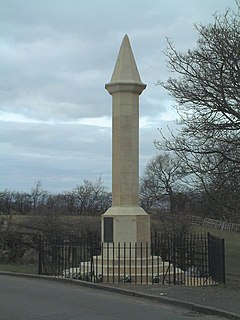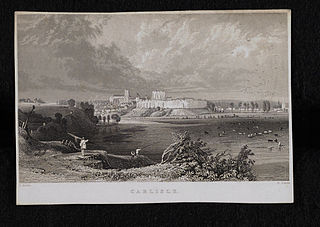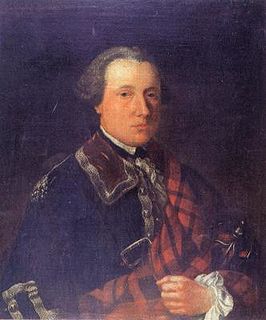
The Battle of Culloden was the final confrontation of the Jacobite rising of 1745. On 16 April 1746, the Jacobite army of Charles Edward Stuart was decisively defeated by a British government force under William Augustus, Duke of Cumberland, on Drummossie Moor near Inverness in the Scottish Highlands. It was the last pitched battle fought on British soil.

The Battle of Preston, also referred to as the Preston Fight, was fought during the Jacobite Rising of 1715.

Ruthven Barracks, near Ruthven in Badenoch, Scotland, are the best preserved of the four barracks built in 1719 after the 1715 Jacobite rising. Set on an old castle mound, the complex comprises two large three-storey blocks occupying two sides of the enclosure, each with two rooms per floor. The barracks and enclosing walls were built with loopholes for musket firing, and bastion towers were built at opposite corners. Destroyed by Jacobites following their retreat after the Battle of Culloden in 1746, the Barracks ruins are maintained as a scheduled monument by Historic Scotland. They are accessible at all times without entrance charge.

The Battle of Falkirk Muir, also known as the Battle of Falkirk took place on 17 January 1746 during the Jacobite rising of 1745. While considered a tactical Jacobite victory, it had little impact on the campaign.

Lord George Murray (1694-1760), sixth son of John Murray, 1st Duke of Atholl, was a Scottish nobleman and soldier who took part in the Jacobite rebellions of 1715, 1719, and played a senior role in that of 1745.

The First Siege of Carlisle was an important event of the 1745–1746 Jacobite rising. Jacobite forces loyal to Prince Charles Edward Stuart captured the city of Carlisle and Carlisle Castle on 14–15 November 1745.

The Siege of Carlisle took place from 21 to 30 December during the Jacobite rising of 1745, when a Jacobite garrison surrendered to government forces led by the Duke of Cumberland.

Archibald Cameron of Lochiel was a doctor and a prominent leader in the Jacobite rising of 1745. On 7 June 1753, at Tower Hill, he was the last Jacobite to be executed for high treason.

Donald Cameron of Lochiel, was hereditary chief of Clan Cameron, traditionally loyal to the exiled House of Stuart. His father John was permanently exiled after the 1715 Rising and when his grandfather Sir Ewen Cameron died in 1719, Donald assumed his duties as 'Lochiel.'
Sir George Munro of Culcairn was a Scottish soldier of the 18th century from Ross-shire, Scotland. He commanded the 3rd Independent Highland Company from 1714 to 1716, fought at the Battle of Glen Shiel in 1719, led the 6th Company in formation of the "Black Watch" in 1725, the 8th Company of Black Watch when it was regimented in 1739 and again commanded an Independent Highland Company in 1745-46. He was shot in error in 1746.

The Siege of Fort William took place in the Scottish Highlands during the 1745 Jacobite Rising, from 20 March to 3 April 1746.

The Jacobite rising of 1745, also known as the Forty-five Rebellion or simply the '45, was an attempt by Charles Edward Stuart to regain the British throne for his father, James Francis Edward Stuart. It took place during the War of the Austrian Succession, when the bulk of the British Army was fighting in mainland Europe, and proved to be the last in a series of revolts that began in 1689, with major outbreaks in 1708, 1715 and 1719.

The siege of the Montaña barracks was the two-day siege which marked the initial failure of the July 1936 uprising against the Second Spanish Republic in Madrid, on 18–20 July 1936, at the start of the Spanish Civil War. The bulk of the security forces in Madrid remained loyal to the government, and supported by workers' militias, crushed the uprising.

The Siege of Blair Castle was a conflict that took place in Scotland in March 1746 and was part of the Jacobite rising of 1745. It was fought between Scottish forces loyal to the British-Hanoverian government of George II of Great Britain, which defended Blair Castle near the village of Blair Atholl in Perthshire, and Scottish Jacobite forces loyal to the House of Stuart.

The Siege of Fort Augustus took place from 22 February to 1 March 1746, during the Jacobite rising of 1745. After a short siege, the government garrison surrendered to a Jacobite force, which then moved on to besiege Fort William, using artillery captured at Fort Augustus.

The Siege of Inverness took place in February 1746 and was part of the Jacobite rising of 1745.

The Siege of Ruthven Barracks that took place over the 10 – 11 February 1746 was part of the Jacobite rising of 1745.

The Siege of Stirling Castle took place from 8 January to 1 February 1746, during the 1745 Rising, when a Jacobite force besieged Stirling Castle, held by a government garrison under William Blakeney.

The Atholl raids of 14 - 17 March 1746 were a series of raids carried out by Jacobite rebels against the British-Hanoverian Government during the Jacobite rising of 1745.

John Gordon of Glenbucket was a Scottish Jacobite, or supporter of the claim of the House of Stuart to the British throne. Laird of a minor estate in Aberdeenshire, he fought in several successive Jacobite risings. Following the failure of the 1745 rising, in which he served with the rank of Major-General, he escaped to Norway before settling in France, where he died in 1750.


















